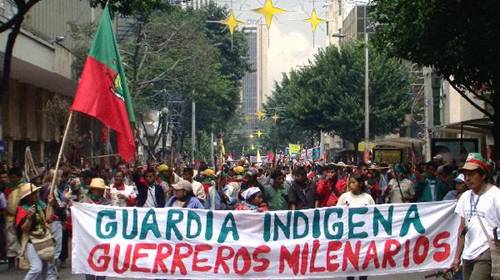The Minga arrives in Bogotá, protests across Colombia and in several capitals

To warm applause from bystanders, the Minga of Social and Community Resistance arrived in central Bogotá on Thursday. That night some 14,000 marchers camped out in the grounds of the National University. Despite drenching rain the university authorities refused the marchers permission to use the buildings’ facilities, and they excluded the press. This demeaning treatment typifies state institutional exclusion of indigenous people, official Colombia’s disregard for the oppressed.
But the oppressed are on the move, and they carry themselves with dignity. As the marchers set off on the morning of Friday 21 November they were joined by women’s organisations, trade unionists, students, afro-colombians and the opposition political party Polo Democratico. Teachers union FECODE, the cane cutters and Bogotá’s mayor Samuel Moreno were amongst the platform speakers. By the time the Minga reached Plaza Bolivar it had swelled to over 40,000 people.
Despite this turn out, the event was barely mentioned in the mainstream media. There are excellent picture on websites http://colombia.indymedia.org/ ; http://www.nasaacin.org/fotos.htm ; www.onic.org.co
There were parallel Mingas in Arauca, Guajira and Nariño. In Arauca 70 indigenous people were detained by the police to stop them from joining a protest on the International Bridge with Venezuela. In Guajira hundreds of women from the Wayúu people, accompanied by Kankuamo, Nasas from Cauca, Wiwas and others started a caravan that will end on 25 November in a forum against the discrimination of women. The caravan is passing through communities to raise awareness of national and regional realities,
"such as the indiscriminate exploitation by turncoat unscrupulous corporations, the plunder and contamination of coal extraction, the systematic assassinations of our people, the sale of everything [even] our air".
The Minga has had a real impact, as Feliciano Valencia, an indigenous leader from Cauca says, "We have come to wake up Colombia!" (Semana 22 November).
The Minga mobilization went international last Friday, breaking through the frontiers of indifference. Colombia’s national indigenous organisation ONIC reports solidarity pickets of embassies in Ecuador, Germany, Spain, Bolivia, UK, Belgium, France and, Ireland. This international dimension is vital. The Colombian government is nervous of more bad press at the time it is desperate to get incoming US president Barack Obama to confirm the Free Trade Agreement, blocked for two years by the Democrat majority in Congress.
The next day, Saturday 22 November, while Uribe was away at a meeting of the Asia Pacific Economic Cooperation summit in Lima, Peru, nine of his ministers were involved in meetings with representatives of ONIC and the Cauca regional organisation CRIC. The ministers issued a statement saying it will take a month to enquire into the role of the ESMAD riot police in attacking the marchers; and giving excuses for not having signed the UN Declaration on the Rights of Indigenous Peoples.
The fact that Uribe used his Lima trip to seal a Free Trade Agreement with Canadian Prime Minister Stephen Harper just confirms the gulf that remains between his government and the vision of the popular movement.
The Minga has decided to keep on mobilising and, in recognition of the diversity of its support and the broad concern for the country’s future, has called for a Grand Popular Congress to be held on 12 October 2009.
* * *
The Nevado del Huila volcano started erupting late on Thursday night. The volcano is in the Tierra Adentro region settled by indigenous peoples, campesinos and African descendants. So far 10 people have been killed.
{loadposition user9}

